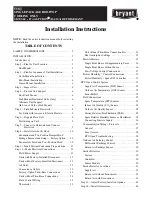
14
C08283
UNIT
VOLTAGE
CONNECT
AS
PRIMARY
CONNECTIONS
TRANSFORMER
TERMINALS
208,
230
240
L1: RED +YEL
L2: BLU + GRA
H1 + H3
H2 + H4
460
480
L1: RED
Splice BLU + YEL
L2: GRA
H1
H2 + H3
H4
575
600
L1: RED
L2: GRA
H1
H2
Fig. 18 -- Powered Convenience Outlet Wiring
Using unit--mounted convenience outlets:
Units with
unit--mounted convenience outlet circuits will often require
that two disconnects be opened to de--energize all power to
the unit. Treat all units as electrically energized until the
convenience
outlet
power
is
also
checked
and
de--energization is confirmed. Observe National Electrical
Code Article 210, Branch Circuits, for use of convenience
outlets.
Fuse on power type:
The factory fuse is a Bussman
“Fusetron” T--15, non--renewable screw--in (Edison base)
type plug fuse.
NOTICE
Convenience Outlet Utilization
Maximum Intermittent use : 15 Amps 2 to 3 Hours
Maximum Continuous use : 8 Amps 24/7
50HJ542739
3.0
A9225
Fig. 19 -- Convenience Outlet Utilization Notice Label
Duty Cycle:
the unit--powered convenience outlet has a
duty cycle limitation. The transformer is intended to
provide power on an intermittent basis for service tools,
lamps, etc; it is not intended to provide 15--amps loading
for continuous duty loads (such as electric heaters for
overnight use). Observe a 50% limit on circuit loading
above 8--amps.
Convenience outlet usage rating:
Continuous usage: 8 amps maximum
Intermittent usage: up to 15 amps maximum for
up to 2 hours maximum
Test the GFCI receptacle by pressing the TEST button on
the face of the receptacle to trip and open the receptacle.
Check for proper grounding wires and power line phasing
if the GFCI receptacle does not trip as required. Press the
RESET button to clear the tripped condition.
Factory--Option Thru--Base Connections —
This service connection kit consists of a
1
/
2
--in electrical
bulkhead connector and a
3
/
4
--in electrical bulkhead
connector, all factory--installed in the embossed (raised)
section of the unit basepan in the condenser section. The
3
/
4
--in bulkhead connector enables the low--voltage control
wires to pass through the basepan. The
1
/
2
--in electrical
bulkhead connector allows the high--voltage power wires
to pass through the basepan. See Fig. 20.
LOW VOLTAGE
CONDUIT
CONNECTOR
HIGH VOLTAGE
CONDUIT
CONNECTOR
C08637
Fig. 20 -- Thru--Base Connection Fittings
Check tightness of connector lock nuts before connecting
electrical conduits.
Field--supplied and field--installed liquid tight conduit
connectors and conduit may be attached to the connectors on
the basepan. Pull correctly rated high voltage and low
voltage through appropriate conduits. Connect the power
conduit to the internal disconnect (if unit is so equipped) or
to the external disconnect (through unit side panel). A hole
must be field cut in the main control box bottom on the left
side so the 24--v control connections can be made. Connect
the control power conduit to the unit control box at this hole.
Units without Thru--Base Connections —
1. Install power wiring conduit through side panel open-
ings. Install conduit between disconnect and control box.
2. Install power lines to terminal connections as shown
in Fig. 14.
Voltage to compressor terminals during operation must be
within voltage range indicated on unit nameplate. See Table
5. On 3--phase units, voltages between phases must be
balanced within 2% and the current within 10%. Use the
formula shown in the legend for Table 5, Note 2 to
determine the percent of voltage imbalance. Operation on
improper line voltage or excessive phase imbalance
constitutes abuse and may cause damage to electrical
components. Such operation would invalidate any applicable
Bryant warranty.
558J































